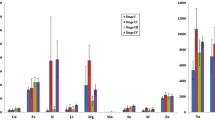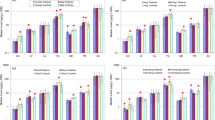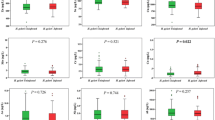Abstract
The objective of this study was to explore hair mercury level in association with chronic atrophic gastritis, a precancerous stage of gastric cancer (GC), and thus provide a brand new angle of view on the timely intervention of precancerous stage of GC. We recruited 149 healthy volunteers as controls and 152 patients suffering from chronic gastritis as cases. The controls denied upper gastrointestinal discomforts, and the cases were diagnosed as chronic superficial gastritis (n = 68) or chronic atrophic gastritis (n = 84). We utilized Mercury Automated Analyzer (NIC MA-3000) to detect hair mercury level of both healthy controls and cases of chronic gastritis. The statistic of measurement data was expressed as mean ± standard deviation, which was analyzed using Levene variance equality test and t test. Pearson correlation analysis was employed to determine associated factors affecting hair mercury levels, and multiple stepwise regression analysis was performed to deduce regression equations. Statistical significance is considered if p value is less than 0.05. The overall hair mercury level was 0.908949 ± 0.8844490 ng/g [mean ± standard deviation (SD)] in gastritis cases and 0.460198 ± 0.2712187 ng/g (mean ± SD) in healthy controls; the former level was significantly higher than the latter one (p = 0.000 < 0.01). The hair mercury level in chronic atrophic gastritis subgroup was 1.155220 ± 0.9470246 ng/g (mean ± SD) and that in chronic superficial gastritis subgroup was 0.604732 ± 0.6942509 ng/g (mean ± SD); the former level was significantly higher than the latter level (p < 0.01). The hair mercury level in chronic superficial gastritis cases was significantly higher than that in healthy controls (p < 0.05). The hair mercury level in chronic atrophic gastritis cases was significantly higher than that in healthy controls (p < 0.01). Stratified analysis indicated that the hair mercury level in healthy controls with eating seafood was significantly higher than that in healthy controls without eating seafood (p < 0.01) and that the hair mercury level in chronic atrophic gastritis cases was significantly higher than that in chronic superficial gastritis cases (p < 0.01). Pearson correlation analysis indicated that eating seafood was most correlated with hair mercury level and positively correlated in the healthy controls and that the severity of gastritis was most correlated with hair mercury level and positively correlated in the gastritis cases. Multiple stepwise regression analysis indicated that the regression equation of hair mercury level in controls could be expressed as 0.262 multiplied the value of eating seafood plus 0.434, the model that was statistically significant (p < 0.01). Multiple stepwise regression analysis also indicated that the regression equation of hair mercury level in gastritis cases could be expressed as 0.305 multiplied the severity of gastritis, the model that was also statistically significant (p < 0.01). The graphs of regression standardized residual for both controls and cases conformed to normal distribution. The main positively correlated factor affecting the hair mercury level is eating seafood in healthy people whereas the predominant positively correlated factor affecting the hair mercury level is the severity of gastritis in chronic gastritis patients. That is to say, the severity of chronic gastritis is positively correlated with the level of hair mercury. The incessantly increased level of hair mercury possibly reflects the development of gastritis from normal stomach to superficial gastritis and to atrophic gastritis. The detection of hair mercury is potentially a means to predict the severity of chronic gastritis and possibly to insinuate the environmental mercury threat to human health in terms of gastritis or even carcinogenesis.




Similar content being viewed by others
References
Saika K, Sobue T. Cancer statistics in the world. Gan To Kagaku Ryoho. 2013;40(13):2475–80. Article in Japanese.
Du Y, Bai Y, Xie P, Fang J, Wang X, Hou X, et al. Chronic gastritis in China: a national multi-center survey. BMC Gastroenterol. 2014;14:21.
Honda S, Hylander L, Sakamoto M. Recent advances in evaluation of health effects on mercury with special reference to methylmercury—a minireview. Environ Health Prev Med. 2006;11(4):171–6.
Yorifuji T, Tsuda T, Inoue S, Takao S, Harada M, Kawachi I. Critical appraisal of the 1977 diagnostic criteria for Minamata disease. Arch Environ Occup Health. 2013;68(1):22–9.
Cheng Z, Wang HS, Du J, Sthiannopkao S, Xing GH, Kim KW, et al. Dietary exposure and risk assessment of mercury via total diet study in Cambodia. Chemosphere. 2013;92(1):143–9.
John J, Wright CY, Oosthuizen MA, Steyn M, Genthe B, le Roux W, et al. Environmental health outcomes and exposure risks among at-risk communities living in the Upper Olifants River Catchment, South Africa. Int J Environ Health Res. 2014;24(3):195–214.
Li P, Feng X, Qiu G, Zhang J, Meng B, Wang J. Mercury speciation and mobility in mine wastes from mercury mines in China. Environ Sci Pollut Res Int. 2013;20(12):8374–81.
Deng H, Wang D, Chen Z, Xu S, Zhang J, Delaune RD. A comprehensive investigation and assessment of mercury in intertidal sn continental coast of Shanghai. Environ Sci Pollut Res Int. 2013;20(9):6297–305.
Mostafalou S, Abdollahi M. Environmental pollution by mercury and related health concerns: renotice of a silent threat. Arh Hig Rada Toksikol. 2013;64(1):179–81.
Park JD, Zheng W. Human exposure and health effects of inorganic and elemental mercury. J Prev Med Public Health. 2012;45(6):344–52.
Li P, Feng X, Qiu G. Methylmercury exposure and health effects from rice and fish consumption: a review. Int J Environ Res Public Health. 2010;7(6):2666–91.
Stern AH, Jacobson JL, Ryan L, Burke TA. Do recent data from the Seychelles Islands alter the conclusions of the NRC Report on the toxicological effects of methylmercury? Environ Health. 2004;3(1):2.
Marques RC, Bernardi JV, Dórea JG, Leão RS, Malm O. Mercury transfer during pregnancy and breastfeeding: hair mercury concentrations as biomarker. Biol Trace Elem Res. 2013;154(3):326–32.
Shao D, Kang Y, Cheng Z, Wang H, Huang M, Wu S, et al. Hair mercury levels and food consumption in residents from the Pearl River Delta: South China. Food Chem. 2013;136(2):682–8.
Marques RC, Bernardi JV, Dórea JG, Brandão KG, Bueno L, Leão RS, et al. Fish consumption during pregnancy, mercury transfer, and birth weight along the Madeira River Basin in Amazonia. Int J Environ Res Public Health. 2013;10(6):2150–63.
Hong D, Cho SH, Park SJ, Kim SY, Park SB. Hair mercury level in smokers and its influence on blood pressure and lipid metabolism. Environ Toxicol Pharmacol. 2013;36(1):103–7.
Vieira HC, Morgado F, Soares AM, Abreu SN. Mercury in scalp hair near the Mid-Atlantic Ridge (MAR) in relation to high fish consumption. Biol Trace Elem Res. 2013;156(1–3):29–35.
Traynor S, Kearney G, Olson D, Hilliard A, Palcic J, Pawlowicz M. Fish consumption patterns and mercury exposure levels among women of childbearing age in Duval County, Florida. J Environ Health. 2013;75(6):8–15.
Zhang L, Wong MH. Environmental mercury contamination in China: sources and impacts. Environ Int. 2007;33(1):108–21.
Valent F, Mariuz M, Bin M, Little D, Mazej D, Tognin V, et al. Associations of prenatal mercury exposure from maternal fish consumption and polyunsaturated fatty acids with child neurodevelopment: a prospective cohort study in Italy. J Epidemiol. 2013;23(5):360–70.
Tai J, Fan F. Effect of hair dyeing on hair mercury. J Inn Mong Univ National (Nat Sci Ed). 2011;26(4):442–5. Chinese.
Author information
Authors and Affiliations
Corresponding author
Additional information
Zeyun Xue, Huiping Xue, Jianlan Jiang, Bing Lin, and Si Zeng contributed equally to this work.
Electronic supplementary material
Below is the link to the electronic supplementary material.
Supplemental Figure 1
The residual analysis and its histogram check in controls. (PDF 102 kb)
Supplemental Figure 2
Standard P-P diagram of regression standardized residuals in controls (Normal probability plot). (PDF 110 kb)
Rights and permissions
About this article
Cite this article
Xue, Z., Xue, H., Jiang, J. et al. Chronic atrophic gastritis in association with hair mercury level. Tumor Biol. 35, 11391–11398 (2014). https://doi.org/10.1007/s13277-014-2475-y
Received:
Accepted:
Published:
Issue Date:
DOI: https://doi.org/10.1007/s13277-014-2475-y




